The Unhealthiest Canned Foods You Can Find At The Store

Sweet convenience and sturdy durability make canned food a luxury that modern home cooks frequently use to their advantage. Being able to stock a pantry to the gills with fruits, vegetables, meats, and sauces for later use is akin to grocery shopping time travel; you can arrange your dining options weeks in advance and have everything on hand when needed — and without requiring a wormhole or a time machine. Once you know the secrets of canned food shopping, it's practically impossible not to want to stack your cabinets with all the elements you need for a wealth of delicious meals that come from a can.
But there are drawbacks to canned foods that make selecting the right products an important task. Among the many myths about canned food and its potentially questionable impact on your physiology are some food facts that prove true. Preservatives like sodium and syrups can have a detrimental effect on the healthfulness of even the most beneficial canned foods. Some items load up on unhealthy fats and strange additives too, taking you even further afield from the prospects of nutritious dining. We scouted out the unhealthiest canned foods found in grocery store aisles to make sure you know what you're better off leaving out of your collection.
Read more: Mistakes Everyone Makes When Shopping At Costco
Spam
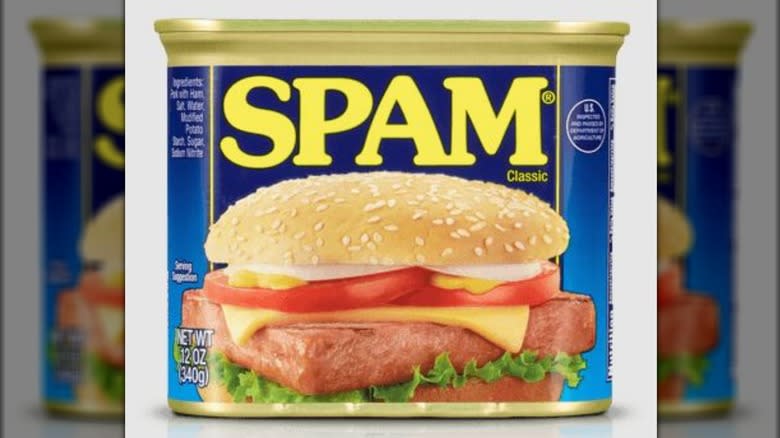
The long-held joke about Spam is that nobody really knows for sure what goes into this canned meat product. The name has been skewered as an acronym for "Spare Parts And Meat," though the manufacturers' website declares the ingredients to be pork with ham, plus salt, sugar, potato starch, and water, none of which explains the gelatinous goop you find cradling the meat cube inside the can. The website also calls out the inclusion of sodium nitrate in the recipe. This preservative is common in cured meats, which also makes it a problem in an industrialized diet; excessive sodium nitrate consumption has been linked with the possibility of colorectal cancer and heart disease, among other potentially chronic conditions.
But all the average consumer has to do is read the nutrition facts on the can to know that Spam isn't a healthy choice among canned foods. A 2-ounce serving of Classic Spam carries 16 grams of fat; 6 grams are saturated, which equates to 30% of your daily recommended intake of this troubling substance. You're also getting 40 milligrams of cholesterol as well as 790 milligrams of sodium, or 34% of what you should have daily — all from a single slice. The can suggests six servings per meat block. No wonder the manufacturers offer lite and reduced sodium Spam options, though these alternatives do nothing to address the sodium nitrate present in all forms of Spam. With so much counting against it, Spam goes on the skip-it list.
Hunt's Meat Flavored Pasta Sauce
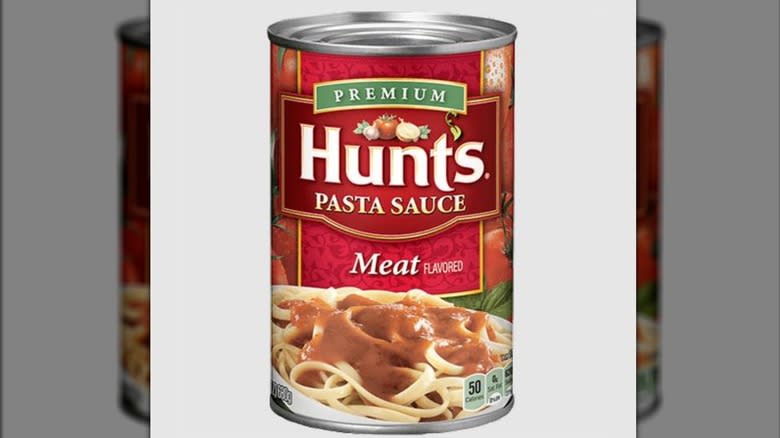
Ah, the classic combination of spaghetti and meat sauce! Has there ever been a simpler, more satisfying pleasure in the history of food? Maybe, but this beloved Italian dish surely ranks high on the list. Having Hunt's meat flavored pasta sauce on deck for a quick cook-up when making your own meal sounds like a great way to keep Old World cuisine within reach. Who wouldn't love to crank a can opener, nuke a bowlful of sauce, and pour it over pasta at a moment's notice?
Despite the temptation, you should think twice before considering Hunt's a viable option for hearty dining that's healthy, too. It turns out this can is a nutritional grenade, blowing up your plans for mindful nourishment. Sodium is the offending ingredient here; each serving of sauce contains 620 milligrams of sodium, or 27% of your advisable daily intake. Considering a serving is 126 grams, or about 4.8 ounces, it's likely you'll be putting more than one scoop on your plate. This only multiplies the sodium in ways you don't want to calculate. Unfortunately for the less disciplined home cooks of the world, homemade sauce is a healthier way to go.
Del Monte Fruit Cocktail In Heavy Syrup

Heavy syrup never appears in anything healthy, and Del Monte fruit cocktail is no exception. This one puts the questionable ingredient right in the name. If you're cracking open a can of cubed fruit, you should already be pretty aware that you're getting a load of sugar in the contents, even without syrup to compound the issue. Though fruit-based fiber helps your body regulate the naturally occurring sugars in the fruit, added sugar increases calories and contributes to blood sugar spikes that can make you feel unwell. This is why fresh fruit is a more favorable choice to canned fruit soaked in heavy syrup, which combines high fructose corn syrup, sugar, and corn syrup in a trifecta of nutritional bad actors.
How much sugar are you getting in a single serving of this canned ambrosia? The total comes to 21 grams, with 13 of those grams being added sugar. The nutritional label lists "N/A" rather than explaining the percentage of your daily sugar intake this represents, likely due to differences between guidelines for men and women. But per the American Heart Association, men should consume no more than 9 teaspoons, or 36 grams, of added sugar per day, while women should limit their consumption to 6 teaspoons, or 25 grams, per day. Based on these levels, one serving of this syrup-soaked fruit just about covers half of a woman's daily added sugar intake.
Marie Callender's Angus Beef Chili With Beans
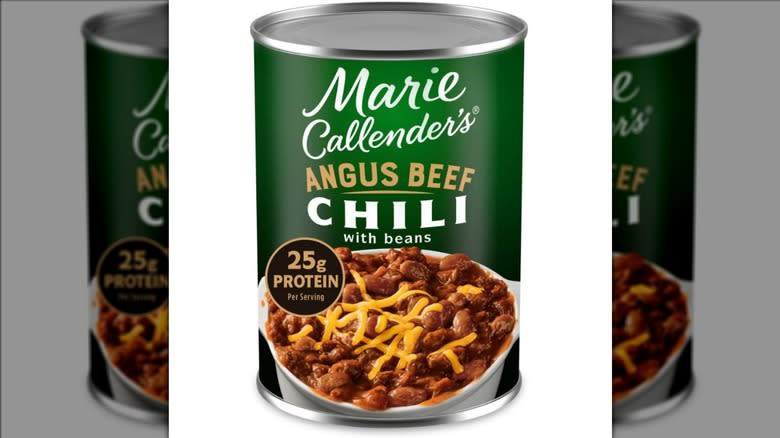
Chili can sure sound like a comforting meal on a brisk winter day. With Marie Callender's reputation for serving hearty dishes, a can of Angus beef chili may seem like just what your favorite TV meteorologist ordered for a midwinter feast. But the nutrition facts on this ready-to-eat banquet say otherwise. Sure, there's a substantial 25 grams of protein in each can-sized serving that totals 560 calories. But the protein shares the can with an incredible 80 milligrams of cholesterol and 32 grams of fat, 12 of which are saturated, equating to 60% of your recommended daily allowance. There's small consolation in knowing you'll be getting 14 grams of dietary fiber, or 50% of what you should be getting, especially when it rides shotgun with 2,100 milligrams of sodium — a mind-boggling 91% of an entire day's recommended intake ... in one serving!
Considering how nice it sounds to grab some canned chili when the weather turns or you're looking for something convenient that tastes good, it's best to leave this can off your shopping list. There are plenty of healthy chili recipes out there that can deliver the same soothing sensation while keeping your well-being in check.
Spaghetti-Os With Chicken Meatballs
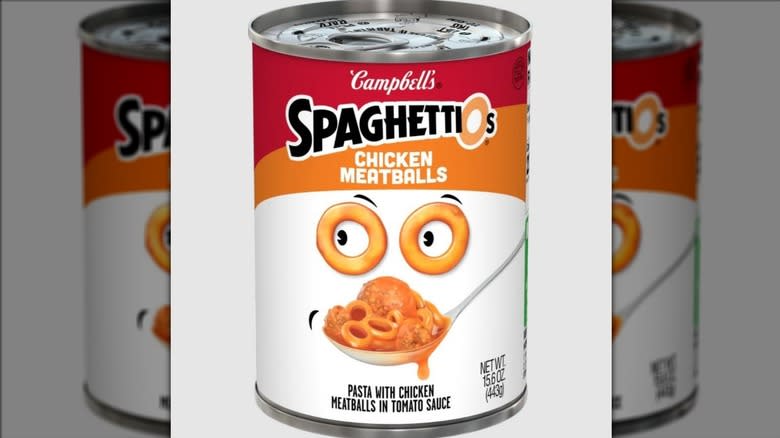
Just because your kids will eat Spaghetti-Os doesn't mean they should. This sub-par pasta in a can has been bouncing around the food world for decades, always with the shady reputation of a less-than food that's only good in a pinch ... and even then, it's not such a great idea. And when Spaghetti-Os with chicken meatballs is considered a pasta dinner, you know the food packaging people are doing their best to sell you on a concept that doesn't just cry "unhealthy," but it also practically belts about it, accompanied by a brass band and a parade down the canned food aisle.
Put aside the fact that spaghetti doesn't naturally occur in O shapes, an indication of the highly processed nature of this dubious canned food. In addition to water and tomato puree, the sauce here contains high fructose corn syrup, a nutritional no-go for junk food like candy and soda that has no place in a child's dinner. And the meatballs are made from mechanically separated chicken, soy protein concentrate, and flavoring, calling to mind the idea that if you can't describe it, you probably shouldn't be eating it. It might seem like an easy win to have a can or two among your stash, but the shady nutritional reality says steer clear.
Chef Boyardee Overstuffed Italian Sausage Ravioli
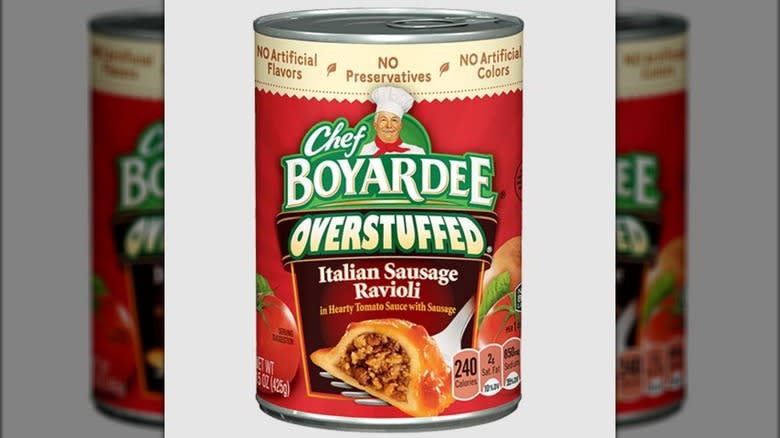
If you're side-eyeing canned food due to the compromising nutrition it presents, you're going to get around to the truth about Chef Boyardee sooner or later, maybe in the form of a can of overstuffed Italian sausage ravioli. The grandpa-like image of the chef himself on the label may lull you into a false sense of gourmet security, but it's important to break the spell and read the nutritional facts on this processed pasta. It's the most direct way for you to learn that a pretty cover doesn't always make for a healthy meal.
It isn't enough that Chef Boyardee stuffs its enriched wheat flour pasta with pork, textured soy protein, and crackermeal (the ingredients read like breadcrumbs, which means more enriched wheat flour). In this can, the Chef overstuffs each pocket with extra pork and crackermeal, so you get a giant blob of filling instead of just a regular-sized blob. The net effect of all these strange food-resembling substances is a single serving that amounts to 5 grams of fat, 10 milligrams of cholesterol, and 750 milligrams of sodium, or 31% of your daily allowance. There are also 11 grams sugar in the mix, likely found in the sauce, which just makes matters even less nutritious. Your family deserves better.
Kroger Apple Pie Filling And Topping
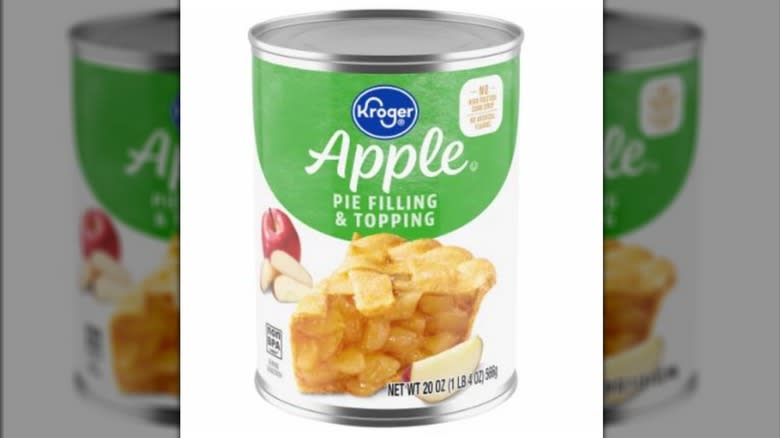
It isn't just the staple canned food items that complicate your dining plans. One-offs like dessert ingredients can also set you back when it comes to feeding your family in a more mindful manner. And if you have a can of Kroger apple pie filling in your grocery cart, you're definitely planning on using it as part of a sweet treat, so there's no use pretending it's destined to be included in a healthy dish. But there are more thoughtful ways to fill a pie (or empanadas, or pastries, or ... whatever ) that give you at least a chance of minimizing the nutritional sacrifice canned apple pie filling can cause.
What's so displeasing about this particular product is the sugar content. Even knowing it's a pie filling, seeing that the 21 grams of sugar per serving include 19 grams of added sugar means only 2 grams come from the apples; everything else is tossed in to sweeten up the scenario. True, the can contains seven servings, which presumably equates to a slice of pie. But when a serving carries 38% of the recommended quantity of added sugars you should have per day, one slice is more than enough to create a crease in your nutritional roadmap. It's especially disappointing when you realize how easy it is to make pie filling from fresh apples using a quantity of sugar that you control.
Dole Mandarin Oranges In Light Syrup
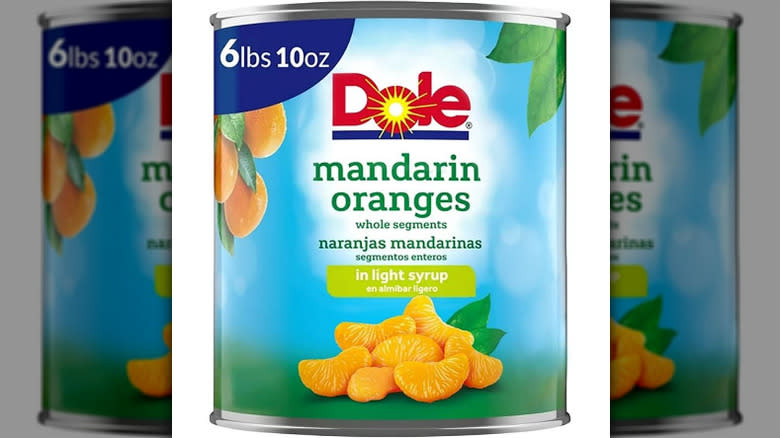
Light syrup may not be as nutritionally offensive as heavy syrup, but it's still syrup. When you break open a can of Dole mandarin oranges in light syrup, you're getting what amounts to fruit swimming in sugar, even though it's a little less than other cans. Light syrup is recognized as a combination of water and sugar, omitting the double corn syrup quotient of heavy syrup. But isn't added sugar in fruit that produces its own sugar just a study in overkill? At the very least, it's a nutrition compromiser that many canned fruit producers seem to be okay with.
These orange segments should be ripe and juicy with no help from syrup of any kind. Instead, Dole hops them up with an additional 15 grams of sugar per serving, taking the count up to 30% of a recommended day's worth of added sugar per half-cup. This results in a 100-calorie single serving of canned mandarin slices; compare that to the 47 calories on average you can get in a whole fresh mandarin, and you're getting double what you should be from the fruit alone. The 10.6 or so grams of sugar in a fresh mandarin are also compromised in the canned variety, thanks to the light syrup. Imagine how much better you'd fare health-wise by springing for a bag of Cuties brand mandarines from the produce aisle. Sure, you have to peel them, but that's kind of like exercise — a healthy fringe benefit!
Progresso Rich & Hearty Chicken & Homestyle Noodle Soup
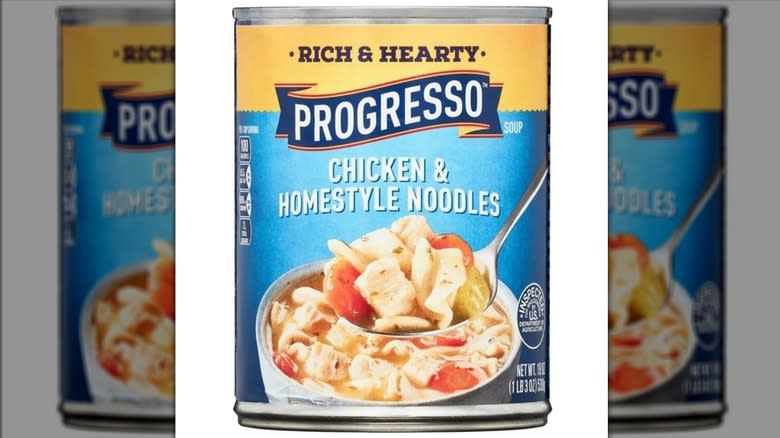
Nothing hits quite like a bowl of chicken noodle soup when you're under the weather — and it's pretty tasty even when you're over the weather, for that matter. But cueing up a can of Progresso Rich & Hearty chicken & homestyle noodle soup can turn your soul-nourishing noms into a nightmare on the nutritional front quicker than you can lift the spoon to your lips. Yes, the classic Progresso soup flavor is bound to be spectacular. It's what makes that flavor so compelling that causes the problem.
Progresso piles on the natural ingredients in this can like nobody's business, making for a 1-cup serving with 110 calories, 2.5 fat grams, and 7 grams of protein, all with a modest presence of cholesterol at 30 milligrams. Not too shabby! However, the 690 milligrams of sodium work against all that goodness, bringing in 30% of your total daily recommended allowance in a single bowl. This is a canned soup that people turn to so they can feel better, but once you know that the salty pleasure comes at a cost, the good feels don't feel so good anymore.
Hormel Canned Ham
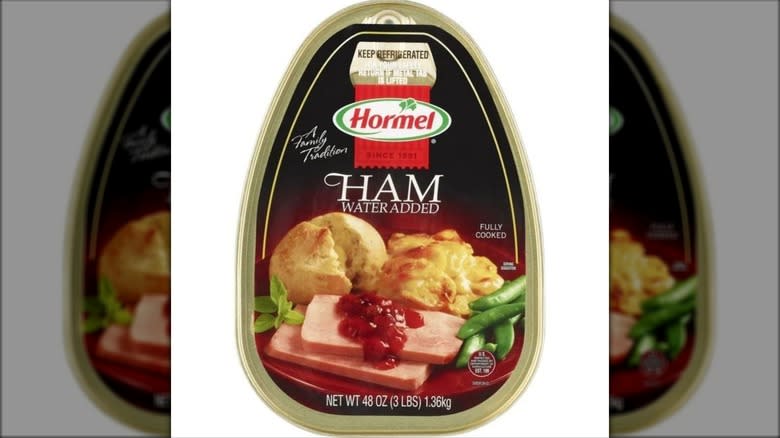
Why wait until the holidays to enjoy a ham dinner, especially when you can pick up a Hormel canned ham, peel back the top, and serve a pre-cooked entrée whenever you're in the mood for it? One good reason to wait — or to skip it entirely — is the sodium content. A 3-ounce slice delivers a whopping 1,050 milligrams of this tricky mineral, or 44% of your advised daily salt intake. Considering that ham is usually the centerpiece of a much larger meal that includes other salted dishes, a single slice is enough to set you on a path to a nutritional mistake.
As with other processed meats, Hormel canned ham also contains sodium nitrate, a commonly used curing agent that can be a problem when consumed in high quantities. Since there's no detailed listing of how much you're getting in each serving, it's best to avoid nitrate-heavy meats for the sake of your well-being. To be fair, non-canned hams also contain sodium nitrate, so maybe the overarching idea of eating ham should be off the table where healthy eating is concerned. It should be eaten in moderation in any form, if at all.
Del Monte Sliced Peaches In Heavy Syrup
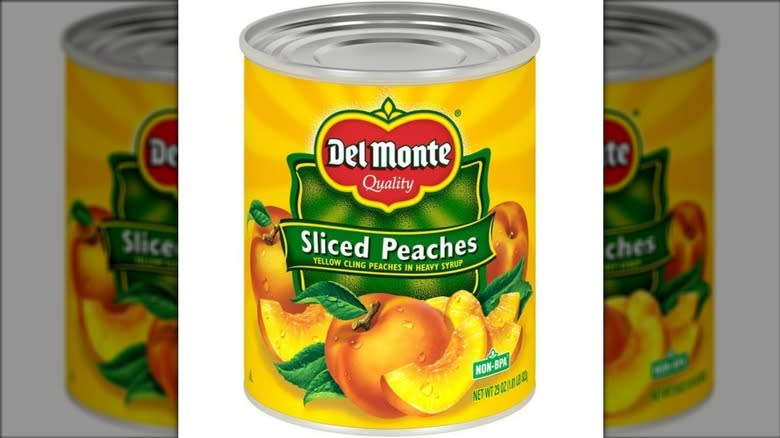
Peaches are a lovely lower-sugar fruit that provide incredible sweetness and floral flavor in their fresh form. So why on earth would Del Monte pack its canned peaches in heavy syrup? The possibility of the company doing its factory-best to maintain color and flavor for its shelved products seems like a logical reason, but it's nonetheless a mistake common in canned fruit in general. Clearly, it doesn't address the notion that fruit can be part of a healthy diet, which means shoppers should educate themselves on the effect that heavy syrup has on the overall nutrition of the what's packed inside the can.
How much does the added sugar in Del Monte's heavy syrup affect the peaches it clings to? Of the total 21 grams of sugar in a single serving, 14 grams are added — a full 33% of the overall sugar content and a fair amount of the recommended daily allowance for both men and women. Even a fresh peach contains around 11 grams of sugar, which means that without the syrup, you could be getting less sugar from a serving of Del Monte product than from the tree-picked original. There's an incredible difference made by the addition of extra sugar in this canned concoction that takes your health goals off-track, even when eating more fruit is part of the plan.
How We Chose Our Unhealthy Canned Foods

We sought out canned foods that were high in calories, which usually arises from the fat content, so we looked at that as well. More often than not, they went hand-in-hand (or can-in-can, as the case may be), so we found a few obvious choices. We also looked at sodium, a known culprit in compromising the healthiness of canned food when used for flavor, for preservation to prolong shelf life, or both. There were some obvious choices, of course; highly processed Spam is unlikely to make anyone's healthy eating round-up, and canned fruit of any kind in heavy syrup is begging to be called on the carpet.
Finding one or two aspects of the label read-outs for our chosen cans was expected. What was surprising was finding an item like Marie Callender's Angus beef chili, which tipped the scales with almost every undesirable ingredient we had in mind, other than sugar. But our process is easy for shoppers to follow: Read the labels of the canned foods you choose, and opt for items with lower calories, fat, sodium, cholesterol, and sugar. If you can circumnavigate super-processed foods like canned meats too, so much the better.
Read the original article on Mashed

 Yahoo Lifestyle
Yahoo Lifestyle 
